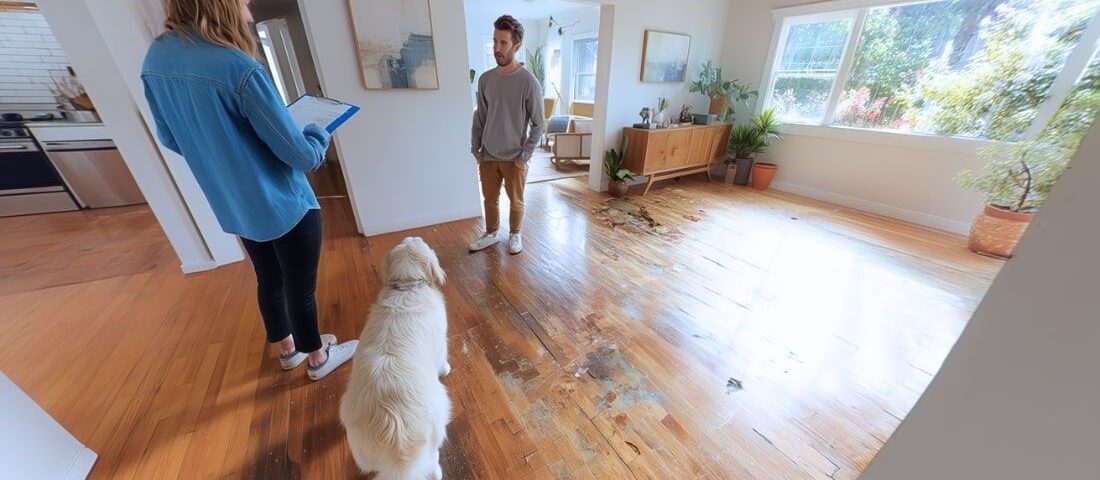
More than 40% of U.S. renters search specifically for pet-friendly rentals. Recent studies show that twice as many renters prioritize pet-friendly listings over any other amenity.
Opening your property to pets could help you tap into this market. It can help reduce vacancy rates and, in some cases, allow you to command higher rent. However, allowing pets into a rental property introduces additional responsibilities. You should be aware of the financial costs and legal liabilities associated with offering pet-friendly rentals.
This post outlines what to expect and how working with a professional property management team helps protect your investment.
5 Costs and Liabilities of Owning Pet-Friendly Rentals
1. Increased Wear and Tear & Property Damage
Pets can cause more wear and tear than typical tenants. Scratches on hardwood floors, chewed trim, damaged blinds, and torn screens are common issues associated with pets.
Industry estimates show that pet damage costs an average of $210 per long-term tenancy. That might not sound like much, but it can add up if you own several rentals. You’re looking at costs like refinishing floors, cleaning or replacing carpets, new paint, and removing stubborn odors. Owners must account for these costs if they allow pets in their rentals.
2. Higher Cleaning, Maintenance, and Pest Control Costs
Properties allowing pets require more intensive cleaning between tenants. Pet fur, dander, and accidents make professional carpet and upholstery cleaning a necessity.
Roughly 20% of people suffer from pet allergies, so thorough allergen removal is key if you want to keep your property marketable.
Then there’s pest control. Even responsible pet owners can’t fully eliminate the risk of fleas or ticks. These additional services increase your turnover costs compared to properties without pets.
3. Risk of Pet-Related Injuries and Accidents
Here’s where things can get especially risky: injuries caused by a tenant’s pet. If a dog bites, scratches, or otherwise harms someone on your property, that person could hold you liable.
Liability extends beyond individual units to shared areas, such as hallways and yards. Breed restrictions help limit risk, but they don’t remove it. And remember, service animals and emotional support animals are protected by law, regardless of breed.
4. Complex Insurance Implications and Coverage Gaps
Many standard homeowner’s insurance policies exclude coverage for rental activities. Landlord policies often limit coverage for pet-related incidents, especially for certain dog breeds.
You must carefully review your insurance coverage. Specialized landlord policies may be necessary to protect against pet-related damages and injuries.
Without proper coverage, you risk significant out-of-pocket expenses. Some insurers might hike your premiums or refuse coverage entirely if you allow pets.
5. Navigating Fair Housing Laws and Service/Emotional Support Animals
When it comes to assistance animals, it is a matter of tenant rights. Landlords must comply with fair housing laws and make reasonable accommodations for individuals with service animals. These aren’t considered pets under the law. That means you can’t charge pet fees, enforce pet deposits, or apply breed restrictions.
Missteps here can result in numerous costs, including legal disputes, fines, attorney fees, and even damage to your reputation. You need to understand how to review documentation, process requests, and stay compliant. Mishandling these situations is one of the most common legal traps for landlords.
Protect Your Property and Your Investment
Pet-friendly rentals can be profitable, but they come with added risks. From maintenance costs to legal liabilities, you need to weigh the full picture.
Working with a professional property management company simplifies this process. Southern Dreams Rentals helps you protect your investment, comply with legal standards, and maximize rental income.
Don’t let the complexities of pet-friendly rentals hold you back. Let Southern Dreams simplify ownership. Visit our website or contact us today to discover how we safeguard your investment and maximize your property’s full potential.



